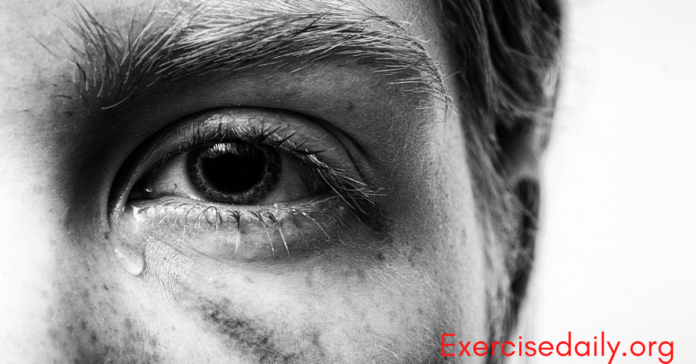Table of Contents

Blinking is a semi-autonomic eye function that is controlled by the ‘blinking system’ in the brain.
A typical human eye blinks about 42,200,000 times per year which means almost 10,000 blinks per day or 12 to 15 blinks per minute. Hence, it is considered the most active muscle of the body. But what if your eye hurts when you blink?
Under normal conditions, this activity is so rapid that we rarely notice it. But a slight malfunction of such a systematic process is enough to irritate you.
Eye pain encompasses the disorder of all the structures related to the eye—be it the eyelid, cornea, lens, pupil, iris, or the whole eyeball. In this article, we will discuss the possible reasons /medical conditions of eye discomfort when you blink—along with the leading causes, symptoms, and of course, treatment.
Make sure you read the whole article to pinpoint the answer to ‘WHY MY EYE HURTS WHEN I BLINK?’ So here you go!
MEDICAL REASONS
Below is a list of common eye disorders that hurt eyes when you blink. These problems range from minor injuries to severe diseases. The names are:
- Fatigue or eye strain
- Acute trauma/Injury
- Conjunctivitis
- Stye and Chalazion
- Blocked or Infected tear duct
- Corneal ulcer
- Dry eye syndrome
- Optic neuritis
Let’s discuss each problem one by one in detail:
1.Fatigue or Eye Strain
The unpleasant feeling of tiredness due to the excessive focus on a particular spot for an extended period is called eye fatigue. Fatigue is a common eye problem, but it is rarely severe. It has no long-term effects on vision unless there is some underlying eye disorder. So if you feel that your eye hurts when you blink, you might be suffering from eye strain.
Causes:
Excessive screen usage for a long time, exposure to too bright or too dim light, reading on digital devices are common causes of eye fatigue.
Symptoms:
The subject shows;
- Watery eyes or, in some cases, dry eyes are observed.
- Inability to maintaining focus on something.
- A sleepy feeling accompanied by a headache
- Redness in the eyes
- Itching, tiredness, or burning of the eyes
Treatment:
Fatigue can be cured by taking proper rest. No heavy doses of medicines are required. Washing the face with cold water can help reduce the itching in the eyes. Cold compressors can also be used for this purpose.
- Acute Trauma/ Injury
Besides, to be the most active organ, the eyes are also the most fragile body organs.
Acute eye trauma occurs due to an accident, entry of foreign particles into the eye, or the introduction of dangerous chemicals to the eye.
Whatever the case, the person gets irritated, and the first thing that comes to his mind is that my eye hurts when I blink. There should be something in the eye. And he rubs the eye. This rubbing is sometimes so harsh that the agent(like glass) leaves the look with a scratched cornea. It leads to serious eye problems like corneal abrasion.
So how would you spot that there is some foreign agent in your eye?
Symptoms
You might feel;
- Difficulty in blinking
- An increased tear flow
- Eye turns red due to rubbing
- Irritating eyes
- Swelling in the eyes
- Blurred vision
Causes
Anybody at any time can get eye injuries.
While playing sports, something hard hits the eyeball, and the eyes are injured. Mishandling of chemicals, irritants, and detergents also leads to eye injuries. Trauma occurs in case of accidents as well.
Treatment
More than 80% of eye injuries can be avoided by using protective eye wares. Never rub the eye if the particle is glass. The cornea and the lens might get injured.
Rinse the eye with water for the removal of harmless particles. Seek medical help in case of corneal abrasion.
- Conjunctivitis
Conjunctivitis is the infection of the Conjunctiva that spreads over the surface of the eye. It results in the inflammation of the blood vessels giving rise to the redness of the eye. That is why; it is also known as PINK EYE.
The infection can be viral, bacterial, fungal, or parasitic, depending upon the cause that produces it. Conjunctivitis is highly contagious but rarely severe. It does not affect the typical vision of the subject.
Causes
Wearing an Infected contact lens can cause conjunctivitis. Contaminated makeup products spread conjunctivitis. Poor hygienic conditions such as dirty pillow covers, bed sheets, clothes result in conjunctivitis.
Symptoms
- Red eyes that look weird
- Tearing in the eyes
- Pain and itching in the eye
- Increased sensitivity to light due to corneal damage
- Thick discharge of liquid (pus) from the eye, especially just after waking up.
Treatment and precautions
The treatment mainly depends upon the cause of the infection. If the disease is caused by;
- Bacteriaantibiotics are used in the form of eye drops, ointments, or pills.
- Virusantiviral medicines are prescribed.
- Irritantsrinse the eye with water well.
- Allergy if an allergy is a cause behind conjunctivitis, it is to be treated first.
Other than this, ensure better hygienic conditions. Don’t share contact lens or makeup items. Change bed sheets and pillow covers after regular intervals of time.
- Stye and Chalazion
People suffering from Stye or Chalazion often make complaints like, “My eye hurts when I blink.” The person himself can spot this disease. While looking into the mirror, if you notice a bump in your eye or somewhere around the eyelash, you might have a:
-
- Stye
or
-
- Chalazion
Spyeis a round, red infectious inflammation on the eyelash. STAPHYLOCOCCUS bacteria cause it. ASpyeis also called a Hordeolum. It is quite painful and Irritating. The bump is small, acute, and localized.
On the contrary, Chalazion is the internal inflammation of the eyelid. On the base of each eyelid, there is a layer of oil glands. When harmful extrinsic particles land on the eyelid’s surface, they penetrate deep into the oil gland. It blocks the oil gland, and pus is produced in them.
In short, Chalazion is the infection of the oil glands.
- But unlike stye, a chalazion is large and not so painful. These are not contagious, but the infection can spread over the face if preventive measures are ignored, or the subject touches infected hands on other areas of the face. Both heal themselves from 3-7 days by using painkillers only.
No long-term vision loss is observed.
Symptoms
Following are a few symptoms of stye and Chalazion:
- Swelling in/on the eyelash.
- Fever and chills due to pain
- Discomfort in blinking the eye
- Temporarily blurred vision due to swelling that creates pressure on the eyeball.
- Headache
- Pus discharge
Treatment
- A warm compressor relieves the pain.
- Rinse the eye gently with mild soap water or baby shampoo mixed in water.
- Massage the eye area but make sure the pimple does not pop up.
- See the doctor if the sore does not heal, pain becomes unbearable, or you notice that the infection is spreading over the face.
- Antibiotics and ointments are usually prescribed to cure it.
- In some cases, the node does not heal in a given time, even after medication. In such cases, the doctor might pierce it.
- Blocked or Infected Tear Duct
If you think that your eye hurts when you blink due to the overflow of tears, you may have a blocked tear duct.
The partially or entirely blocked tear duct alters the regular drainage system of the tears into the nose. You may notice red, irritating watery eyes.
From infancy to old age, it can be observed at any age. It is most common in babies. Some children have blocked tear ducts since infancy. It gets normal during the first year of the infant without having any treatment— as it is correctable.
Causes
The causes of a blocked or Infected tear duct vary from person to person. Some are:
- Inflammation of the duct
- The exceptional growth pattern of the nearby bones on the face
- The tear duct can be blocked due to some injury, infection, or tumour around the nose.
- Antiglaucoma drugs
- Long-term use of steroid drops, medications used to cure cancer is also responsible for it.
Symptoms
- Over tearing followed by blurred vision
- Fever
- Redness of the white portion of the eye
- Pink eye infection
- Mucus discharge from the eyelids due to infection
- Swelling of the eyes
Treatment
The treatment depends upon the age of the patient and its cause.
- Sometimes only oral antibiotics are enough to treat the infection and inflammation.
It is to be noted that antibiotics can only be used to treat the infection. They do not fix the actual tear duct.
- A painless surgery is also performed if the tear duct does not unblock after a given time.
- Corneal Ulcer
If there seems an open sore on your cornea and your eye hurts when you blink, you better make an appointment with the optometrist. Because it can be a corneal ulcer which is a severe eye ailment, keratitis is another name for corneal ulcer.
The cornea is a transparent membrane that covers the iris and the pupil. It is responsible for absorbing the surplus light that falls on the eye.
Unlike other mild diseases, it is a severe infection of the cornea. If left untreated, it badly damages the cornea that leads to permanent vision loss.
Causes
People who have burned or damaged cornea quickly get a corneal ulcer. Another cause is the deficiency of vitamin A. Steroid drops, wearing the contaminated lens, and cold sore contribute to its occurrence. Other causes include bacterial, fungal, and parasitic attacks on the cornea.
Symptoms
- The patient feels as if there’s something entrapped in the eye.
- This annoying feeling produces redness, dryness, swelling, and severe pain in the eye.
- A white spot on the cornea is visible.
- Sensitivity to light, pus discharge, and tearing are the common symptoms.
- Blurred vision
Treatment
- It needs immediate treatment. So consult an optometrist as early as possible.
- Patients with severe corneal ulcers go through corneal transplants by which the damaged cornea is replaced. But itis a risky treatment.
- Dry Eye Syndrome
The next disorder on the list is when your eye hurts when you blink, the Dry Eye Syndrome.
It involves the itchy condition in which the eye fails to produce enough lubricant (tears) for normal functioning. Consequently, whenever you blink the eye, it hurts due to friction. The surface of the eye is inflamed and turns red. The cornea experiences scratch due to the extreme dryness that affects normal vision.
It is neither severe nor contagious. However, the watery surface provides a medium for bacterial growth that amplifies the severity of the problem.
Causes
- Eyes become dry with ageing.
- Dry weather increases the dryness of the eyes.
- Smoking
- Prolong usage of antidepressants.
- LASIK eye surgery temporarily dries the natural lubricant of the eyes. But it goes away as time passes.
Symptoms
The symptoms of dry eye syndrome are as follows.
- Stringy mucus production in the eyes.
- Dry eyes.
- Itching, burning, and blurred vision produce painful sensations.
Treatment
- Artificial tears are recommended and widely used to cure dry eye syndrome.
- Anti-inflammatory medicines are prescribed.
- Some instruments are installed in the eyes via surgery to limit the tear flow through the tear duct in severe cases.
- Optic neuritis
The nerve that connects the eye with the brain is called the optic nerve. Optic neuritis is the damage of the optic nerve. It is the beginning of many severe eye disorders—for example, multiple sclerosis(MS).
Usually, it affects one eye at a time.
Causes
Some causes of optic neuritis are apparent and can increase the risk of damage. Such as:
- Genetic mutation
- Some diseases like mumps, measles, and Sinusitis increase the chances of optic neuritis.
- People who are in their late adulthood are prone to get it.
Symptoms
The typical conditions which are associated with this ailment are:
- A sense of pain when the eye is moved.
- Sideway vision loss (temporarily)
- Dyschromatopia
A condition in which the eye loses its ability to see colours
- Photopsia
Sparkles of light in the eye
Treatment
Steroid medicines such as corticosteroids are used that speed up the healing process of the nerve. In the majority of cases, vision recovers as the damaged optic nerve heals.
GENERAL TREATMENTS
Acute eye disorders can be cured with at-home treatment. No medical course is required. For instance:
- Warm compressors to relieve pain
- Cold compressors to get rid of itching
- Soap water to rinse the eyes
- Ointments to treat the infection
- Limited screen usage
- Avoid sharing mascara and contact lens
But severe illness cannot be controlled only by taking these measures. For such cases, a competent optometrist can help better.
FINAL WORDS
Eyes are delicate sense organs. A slight disturbance can affect usual functioning. Even symptoms as minor as the eye hurts when you should not be ignored as it can be the cue to some serious underlying problem.






